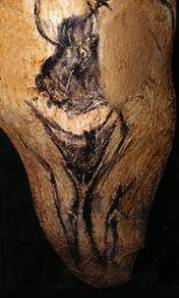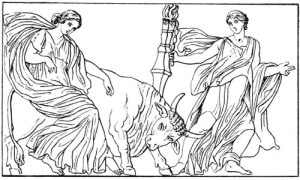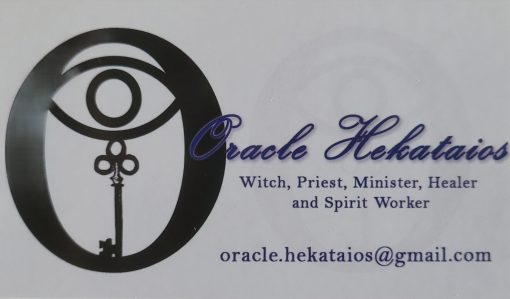
The sanctity of the Bull as a symbol for the Sacred Masculine can be found as early as the Paleolithic cave paintings of Lascaux, Livernon and Chauvet in France. During the Bronze Age (4000 – 1700 BCE) the Spring Equinox occurred during the constellation Taurus due to the Precession of the Equinoxes[i]. Currently it occurs in the constellation Aries (the Sacred Ram). During the Age of Taurus the Myths of many cultures personified the life forces as a Bull that needed to be slain so that the Cosmos would continue. As a result, many cultures and religions celebrated their New Year on the Spring Equinox. The New Year would entail the sacrifice of an actual bull, reenacting the First Sacrifice that made the Cosmos possible, as everything that exists was said to be made from parts of the Bull. Cultures and religions that had these mythic motifs included the Persians, the Mesopotamians, the Minoans, Eastern Anatolia (where Phrygia was located), the Indus Valley, the Gaulish Celts, the Canaanites, and the Thracians. Interestingly, the Sacred Bull was also linked to the Goddess Hekate. In the Greek Magical Papyri, a collection of texts with spells and incantations dated from the 2nd century BCE – 5th century CE, Hekate is addressed in the Prayer to Selene as “O Night Bellower, Lover of Solitude, Bull-Faced and Bull-Headed One,” and “Bull-Eyed, Horned, Mother of Gods and Men.”
Dionysus and the Bull
Dionysus was also described as being “bull-horned.” In the Orphic Hymn to the God of the Triennial Feasts[ii], the hymnist writes, “I call upon you, blessed, many-named and frenzied Bacchos, bull-horned Nysian redeemer, god of the wine-press, conceived in fire.” Other hymns go on to say that He is “bull-faced.” Dionysus may have had origins in Crete, where the Sacred Bull was especially venerated. The Sacred Bull was linked to the symbolism of the Moon. A Zoroastrian prayer says that the “Moon is the Seed of the Bull.” Apis, an Egyptian God who is another form of the Sacred Bull, was illustrated with the Moon between his horns. Shiva is linked to the Sacred Bull, and drawings often show him with a Crescent Moon on His brow resembling horns. The Minoan Horns of Consecration sculpted to represent the horns of the Sacred Bull, I believe symbolize the powers of the Moon. The Egyptian God Ptah was said to incarnate as a black bull created by moonbeams. This connection of the Sacred Masculine to the Moon may be rather startling to find since many modern Pagans, familiar with Wicca, have come to symbolize the Moon as a solely female. As we are seeing, the ancient world was not so easily divided.

Minoan Sacred Bull
The Sacred Bull was particularly venerated in Crete, where representations of Sacred Bulls can be found everywhere. According to the Orphic Hymns, Dionysus was born in Crete. The name itself, Dionysus, was first found in Mycenaean fragments known as Linear B. The Linear B alphabet predates Greek by several centuries, and was found mostly in the Minoan capital city of Knossos. It is descended from the older Linear A alphabet spoken by the Minoans, and as of this writing remains undeciphered. This language was formed after the language found in Linear A, confirming the Orphic Hymns that Dionysus may have originated from the Minoan Civilization. Or, perhaps an archetypal Deity like this has always existed in various forms in various cultures? What we do know is that in Minoan Crete He was given the name Zagreus, a title for a hunter who captured live animals. As Zagreus, He was identified as the Cretan Zeus. Carl Kerenyi[iii] stated that the title was rooted in Minoan Mythology.

The Sacrifice of the Bull
Rites depicting the Sacred Bull would always recreate the creation of the Cosmos and humanity by sacrificing a bull. The sacrificial death of the Sacred Bull was seen as a dismemberment of the God Himself. His flesh and blood, eaten by His worshippers, would be viewed as the God investing His very Presence into the bodies of His followers, granting them a portion of His Divinity (known as theophagy, or “God-Eating”). This omophagia (eating raw flesh) would ensure immortality. Such a sacrifice occurred among raucous festivals on the island of Crete every two years. At the height of the ritual when the Bull was killed, a basket would be held aloft showing the survival of the heart[iv]. In Orphic Myth, seven Titans sought to dismember the infant God. In order to escape, Dionysus shape-shifted into various animals, the last being a young Bull. They tore Him into seven pieces (diasparagmos) and ate His flesh. They were killed by Zeus, and the only surviving piece of flesh was His heart.
Cakes and Ale
The reenactment of the sacrifice of the God lives on today in the Cakes and Ale portion of many Pagan rituals, although many usually just see it as the “grounding” portion after performing a ceremony. Between the main part of the ritual and the end when announcements are made, Cakes and Ale are usually handled as a brief “snack break” that is there just because. I wonder how many realize the significance of Cakes and Ale as the modern Pagan continuation of the ancient custom of the Sacrifice? To simply view the Cakes and Ale as a mere “add-on” in ritual removes the importance of the Cakes and Ale from its origins as the very embodiment of the Divine into humanity. In ancient times the animals that were sacrificed were very often shared among the ritual participants. This was viewed as partaking of the essence of the God. This part of the ancient rituals was often the most important, because it symbolized the reciprocity between the Gods and mortals. The sacrifice itself was a gift of thanksgiving to the Gods so that Their essence was fed by hymns, prayers, worship and offerings. In turn, the Gods would bless the worshippers and renew their life force through the medium of the animal that was the God Incarnate. The cakes are the flesh of the God, and the ale is the blood of the God. What we have here is a return to our Classical Pagan roots in the Eucharist symbolism of the Cakes and Ale. In Roman Catholicism, the Eucharist (or Communion) is the belief that the wafer and wine literally become the flesh and blood of Jesus Christ. This is merely a Christian adoption of what once was a Pagan ritual. In the third century CE, beneath St. Peter’s Basilica in the Vatican[v], a fresco of Jesus shows him with symbols from both Apollo and Dionysus. In this syncretic mosaic are written the words:
“I am the True Vine.”
Dionysus
In our Temple, our religious calendar places the New Year celebrations to take place at the Full Moon closest to the Spring Equinox for a public celebration, and a more private celebration typically for Temple members only held during the Spring Equinox itself. The Sacrifice of the Bull is very important, as in so doing we are reweaving the energies throughout the land itself, and we are participating in the First Sacrifice. We are also remembering that it was by Sacrifice that humans were created: from the ashes of the Titans and the blood of Dionysus Zagreus. Thus, by blood and ash we are ever participating within ourselves the suffering of the sacrifice. Our lives are a gift from tragedy, something that a God had endured, but we were the result.
Ritual is Memory: it is reentering the Sacred Dance and Rites given to us by Dionysus. In ritual we touch the very core of our inner being, bringing forward from the past the power we need to engage the present and ensure the continued existence of the future. That’s what sacrifice is all about: legacy. A legacy built on a continuous gift exchange which was first bestowed upon us. And we have that opportunity to always return it to Them.
Thank you, Dionysus.
Eirene kai Hugieia!
(Peace and Health!)
~Oracle~
Footnotes and Sources:
[i] As the Earth revolves and rotates, it also “wobbles” like a spinning top. This wobble causes the constellation that the Spring Equinox occurs in to change. Because there are 12 constellations, it takes 2167 years (1/12) for the Spring Equinox to rise in each constellation. A complete rotation = 1 Platonic Year (26,000 years).
[ii] The Orphic Hymns translated by Apostolos N. Athanassakis.
[iii] Kerenyi, Carl. (1976). Dionysus: Archetypal Image of Indestructible Life. UK: Princeton University Press.
[iv] Albinus, L. (2000). The House of Hades: Studies in Ancient Greek Eschatology. Aarhus, Denmark: Aarhus University Press.
[v] Morford, M.P.O., & Lenardon, R. (1999). Classical Mythology (6th Ed.).NY: Oxford University Press.

Reblogged this on Die Goldene Landschaft.